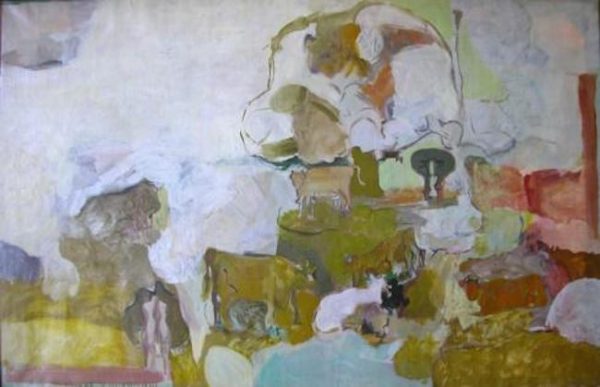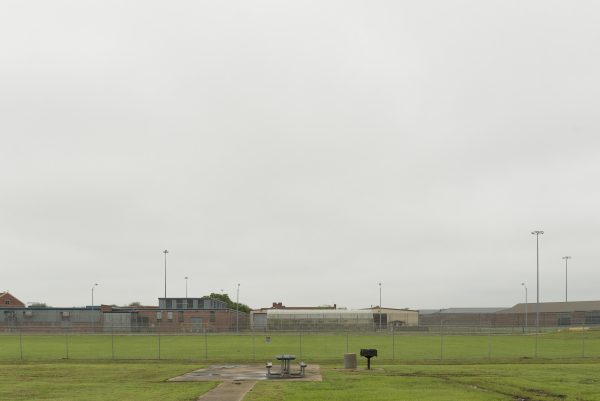Visual Arts Review: Ogunquit Museum of American Art
You will leave the museum stimulated by its provocative presentations of paint, photography, video, and words.
Ogunquit Museum of American Art, 543 Shore Road, Ogunquit, Maine, through October 31.
By Kathleen Stone
In a suite of small exhibitions, the Ogunquit Museum of American Art demonstrates how much power can be generated by art executed in multiple mediums. Lois Dodd’s expressionist paintings, Bill Viola’s video installation, and a joint show of photography and poetry by Jacob Bond Hessler and Richard Blanco illustrate the rich variety of human experience — each in its own way.

Lois Dodd, “Pasture,” 1955, Oil on linen. Photo: © Lois Dodd, courtesy Alexandre Gallery, New York.
Lois Dodd paints in oil, and a small show of her work occupies the center gallery. A resident of New York and Maine, she often sketches and paints outdoors. Cows are a recurring subject. Their black-and-white and brown-and-white hides are accentuated, becoming sinuous shapes that echo clouds and patches of grass. Dodd concentrates on what she sees, rather than on a thing’s identity: animals and landscape become a vehicle for arranging shapes on flat canvas.
The same impetus to study form animates another painting, this one of four female nudes chopping and stacking wood. The idea of unclothed women laboring over a woodpile is, at first, surprising. But throughout art’s long history, nude women have appeared in many incongruous positions, so why not? In truth, Dodd’s take feels liberating. These are women who are active, not lounging or bathing as they so often are in art, and they are accomplishing a chore that is essential to surviving a long Maine winter.
Dodd’s work is fresh and gestural, with nothing overwrought or overproduced. We sense her hand on the page. She gives us a chicken, for instance, with a splash of red for the comb, a soft curve for the body and soft brownish strokes for the feathers. With these sparse details, she conveys a feeling of feathery softness. The women in the wood pile are derived from a model who posed in various active positions, leaving Dodd to transform her sketches into a composition of multiple women in action. Dodd’s understated method insures that the model’s strength-in-movement comes across on the canvas.
In a gallery adjacent to Dodd’s paintings is Boundaries, a collaborative exhibition of Jacob Bond Hessler’s photography and Richard Blanco’s prose poetry. Hessler and Blanco invite the viewer to consider a world without national, gender, racial, or class boundaries. The photographs romanticize that utopian ideal via expansive, open views of sky, sea, and shore. Sometimes, to help ground the picture in our country’s current political discourse, Hessler includes a structure, such as a federal prison or a section of fencing between Tijuana and San Diego County. Blanco’s poetry, though, makes the undertaking’s liberal ideology explicit. Blanco was invited to read at President Obama’s second inaugural; his poem for the occasion was both lyrical and subtly political. Here, while still lyrical, his verse is overtly pointed.

Jacob Hessler, Poetry Assignment #4, {Inmate Creative Writing Program}, {Federal Correctional Institution}, Seagoville, Texas, 2017, Dye sublimation print. Photo: courtesy of the artist.
All the photograph/poetry pairings are compelling, but two in particular stand out. In one, we see the façade of a federal correctional facility. Stretching horizontally across the picture plane, the prison seems almost benign, with minimal fencing and big sky above. Blanco’s words shatter that illusion. His device is to imagine a poetry workshop inside the prison. The teacher has asked the students to write about what they miss most, supplying comments on the submissions. The remarks are kind and encouraging.
Germaine, your poem this week is quite striking – so heartfelt and full of captivating imagery, right from the start.
Still, as the teacher singles out specific lines, a chasm opens between academic appreciation and the dark reality behind the words.
But I’m especially taken by the lines that confess your true “want.” (More than the sun, the sky, or the moon, I want my son. I’ve become nothing but want, but my want and I are locked up.)
Those vivid and tenderly rendered details really bring your son to life. They let me miss and mourn him as you do when you reveal that he died while you were in jail. You close the poem perfectly by grounding it in imagery that lets us feel your sorrow and emptiness. (Words are my only escape now. In this poem, I can turn iron bars into shadows I can walk through.)
In another piece, Hessler has photographed a middle class street in Mobile, Alabama, filled with lush trees and porched houses. The title Michael Donald Avenue (formerly Herndon Avenue) may mean little to most viewers — until the poem reminds us that this the site where in 1981 the Ku Klux Klan lynched a young black man. Blanco’s verse invites us to contemplate the murdered Michael Donald, difficult as that is:
Easier not to look at his shut eyes, wonder what his favorite color or superhero was, if he liked to skateboard or draw, if he heard his mama’s cries: My boy – Jesus, my boy!
By evoking the human suffering that is common between lynching and incarceration, Blanco, at first, makes readers gasp — which then leads us to wonder about other traits they share. Perhaps, for some, a vision of eliminating national boundaries is radical. But Hessler’s and Blanco’s call for significant social change is compelling because it is inescapable.

Bill Viola, “The Fall Into Paradise,” 2005, single-channel video installation, high definition, color, sound; 09:58 minutes, Smithsonian American Art Museum. Photo: copyright 2005, Bill Viola.
In a third gallery, the museum has mounted a video installation by Bill Viola. The Fall Into Paradise was filmed underwater and it starts slowly — with a focus on a point of light. The light grows into ambiguous shapes before emerging as two human beings. I hesitate to describe the video further because it risks destroying the experience. Every viewer should sit in the dark and watch the screen for the nearly ten minute run time so as to absorb the work without being influenced by what others have written.
Packing disparate mediums into a small space, as the Ogunquit Museum has done, runs true to its original vision. Opened in 1953, the museum was the brainchild of Henry Strater, an artist closely aligned with celebrated literary talent of his day. A college friend of F. Scott Fitzgerald and a fishing buddy of Ernest Hemingway, he was also active in Ogunquit’s art colony; his illustrations appeared in early works by Hemingway, Ezra Pound, and Archibald MacLeish. His archives, now part of the museum’s permanent collection, include issues of literary journals, such as the 1924 Transatlantic Review and the Paris Review. The collection also includes a wide swath of early twentieth century paintings, including a notable and stark work by Rockwell Kent.
Under the direction of Michael Mansfield, a recent transplant from the Smithsonian, the museum is going about reinvigorating its exploration of cross-fertilization among artistic mediums. Mansfield is a photographer himself, and his close association with contemporary photography, video, and technology has no doubt added generous dose of the twenty-first century to this summer’s slate of exhibitions. You will leave the museum stimulated by its provocative presentations of paint, photography, video, and words.
Kathleen Stone lives in Boston and writes critical reviews for The Arts Fuse. She co-hosts a literary salon known as Booklab and is at work on several long projects. She holds graduate degrees from the Bennington Writing Seminars and Boston University School of Law, and her website can be found here.
Tagged: Bill Viola, Henry Strater, Jacob Hessler, Kathleen C. Stone, Lois Dodd
